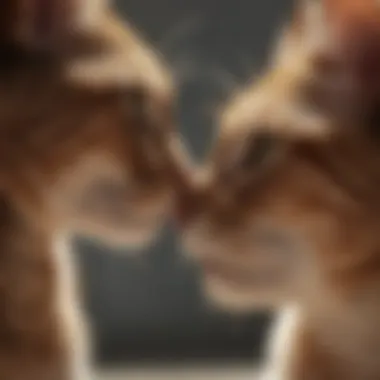Recognizing Feline Estrus: Signs of a Cat in Heat


Intro
Understanding a cat's reproductive cycle can feel like trying to crack a code. Feline estrus, commonly known as being in heat, is a natural yet often perplexing phase in a cat's life. Observing the signs of a cat in heat is crucial for responsible pet ownership. Grasping the nuances of this cycle not only enhances a feline's well-being, but also helps pet owners anticipate behavioral changes that could impact their daily routines.
While many people may overlook these signs, they can significantly affect your cat's temperament and health. This guide serves to illuminate the physiological and behavioral changes cats experience during this cycle. Knowing what to look for can lead to better care decisions that promote your cat's happiness and health.
In this article, we'll discuss everything from key signs of estrus behavior, to health implications, and the timing of these cycles. With this knowledge, you'll be better equipped to support your feline companion and navigate this natural part of their life.
Intro to Feline Estrus
Understanding feline estrus is vital for anyone who considers themselves a dedicated cat owner. The ability to recognize when a cat is in heat can not only alleviate confusion but also aid in making informed decisions about their care. For many, cats are cherished members of the family, and ensuring their well-being is paramount. Estrus, or heat, is a natural part of a cat's reproductive cycle, but it often comes with an array of changes that can catch owners off guard.
Defining Estrus in Cats
Estrus in cats refers to the period when female cats become receptive to mating. This is commonly known as being 'in heat.' Typically occurring every few weeks, estrus can last anywhere from a few days to over a week, depending on various factors such as the cat's age, breed, and overall health. During this time, hormonal shifts influence both the cat's body and behavior. Often, this results in physical manifestations, such as a more pronounced posture, indicative of her readiness to mate. It’s important to note that this cycle is distinct from a cat’s menstrual cycle, as cats are induced ovulators, meaning they will only release eggs following mating. Understanding the mechanisims behind estrus is important for ensuring that a cat's experiences during this time are met with proper care and response.
Importance of Recognizing Estrus
Recognizing estrus in a cat is crucial for several reasons. First, it helps in planning for responsible pet ownership, including decisions about breeding, spaying, or simply ensuring the comfort of your pet. Many cat owners notice significant behavioral changes during this cycle, which can be challenging to navigate. By being knowledgeable about these shifts, owners can better mitigate disruptions in their cat’s routine, making it easier for both the pet and the human companion.
Additionally, understanding the signs of estrus allows owners to prevent unwanted litters, which can arise if several cats are present and not properly managed. However, it’s not just about avoiding breeding; it’s also about the health and psychological welfare of the cat. A female cat that goes through several estrus cycles without mating can experience stress and frustration. In essence, knowing when a cat is in heat equips cat owners with the insight needed to provide timely care and make decisions in the best interest of their feline companions.
Recognizing the signs of estrus is not just an exercise in awareness; it’s a key aspect of responsible cat ownership.
In summary, the nuances of feline estrus influence many aspects of a cat's behavior and health. Therefore, delving into this subject is not just an academic pursuit but a practical necessity for animal lovers seeking to nurture their pets' well-being.
Physiological Changes During Heat
Understanding the physiological changes that occur during a cat's heat cycle is crucial for pet owners. These changes directly impact a cat's behavior and health, making it imperative to recognize them. When one becomes familiar with how the feline body responds during estrus, it not only helps in providing better care but also aids in making informed decisions about breeding or spaying. Grasping these details supports the overall well-being of the pet, ensuring the owner is well-equipped to manage a cat in heat.
Hormonal Fluctuations Explained
During estrus, a cat's body undergoes a series of hormonal changes, which are quite significant. The main hormone involved is estrogen, which peaks as the heat cycle progresses. This surge triggers various physiological and behavioral changes. For instance, the feline body prepares for possible mating, leading to a series of adjustments aimed at attracting potential mates.
As the estrogen levels rise, one can expect increased vocalizations, often more pronounced than usual. This is not just a matter of sound; it's a call to male cats, signaling availability. Alongside these vocal changes, a notable shift in behavior can occur. Some cats may become more affectionate, seeking attention from their owners or other animals, emphasizing their desire to mate.
Hormonal fluctuations are not only about attracting mates; they also affect the cat's overall mood and energy levels. Increased energy might lead to unexpected bursts of playfulness, while at other times, the same cat might exhibit a tendency to isolate. Recognizing these hormonal ebbs and flows helps a cat owner anticipate changes, making interactions smoother during this period.
Physical Changes in the Cat's Body
Besides the internal hormonal changes, there are also physical changes in a cat's body that signal heat. One major aspect to pay attention to is the cat's vulva, which becomes swollen and more pronounced when the cat is in estrus. This change can often serve as a visual cue, indicating that it might be the right time to take necessary precautions.
Furthermore, cats in heat may exhibit increased grooming behavior. They tend to pay more attention to their genital area as a natural instinct to clean themselves, preparing for the mating process. Additionally, the body might experience slight temperature changes; hence, it is essential for owners to observe if their cat feels warmer than usual.
In many cases, these physical signs are accompanied by more noticeable restlessness or desire to roam around the house. A cat might spend hours moving from one place to another, exploring nooks and cranny in search of potential mates. This behavior can also include attempts to escape if they sense male cats nearby.
Overall, understanding these physiological indicators fosters a deeper bond between pet and owner. As a responsible pet owner, observing these signs and changes helps ensure that proper care and management are in place during this temporary but vital phase of a cat's life.
Behavioral Indicators of Heat


Understanding the behavioral indicators of heat is crucial for cat owners as it serves not only to recognize the signs that a cat is in estrus but also helps in managing the overall well-being of the pet. Cats are creatures of habit, and during their heat cycle, they exhibit changes that can be quite striking. Recognizing these changes assists in determining the right actions to take, whether that means providing comfort to the cat or intervening in some way to prevent unwanted behaviors.
Many owners often overlook the subtleties of their cat’s behavior, missing important signals that indicate their furry friend is not their usual self. Noticing these behavioral shifts not only fosters a stronger bond between owner and pet but also facilitates informed decision-making regarding care and management.
Vocalizations and Their Meanings
One of the most noticeable indicators of a cat in heat is her vocalizations. A common picture is a cat that suddenly becomes quite chatty—a far cry from her normal meowing. This increase in vocal activity isn’t just for show; it serves a purpose.
When in heat, a female cat may engage in loud yowls or cries, which are significantly different from the soft murmurs she usually makes. These sounds can be loud and often startling, both to humans and other pets. The underlying message in these vocalizations is clear: she is signaling her readiness to mate.
- Purpose of Vocalizations:
- Attract potential mates
- Warn off other female cats
- Communicate distress or discomfort during this transitional phase
The unique sounds can sometimes leave cat owners questioning whether their pet is in distress or simply seeking attention. It's essential to recognize that this behavior is normal during the heat cycle and part of her natural instincts.
Affectionate Behavior Patterns
In addition to vocalizations, a cat in heat typically becomes unusually affectionate. This sudden increase in need for attention can be surprising, especially if the cat has been more aloof previously. She may follow her owner around, seek out petting, and even roll over to expose her belly, a body language that usually could signal trust and a desire for interaction.
This affectionate display is often an expression of her heightened hormonal activity, as she seeks companionship—a behavior indicating her readiness for mating.
- Common Affectionate Traits:
- Increased proximity to humans
- Purring more frequently
- Rubs against furniture and humans more intensely
While some may find this attention charming, it can sometimes be overwhelming or excessive, causing frustration for the owner. Understanding the context of these behaviors can help in managing the situation more effectively.
Increased Restlessness and Marking Behavior
Another strong behavioral marker during a cat's heat cycle is increased restlessness. Cats may seem unable to settle down, acting fidgety and agitated. This restlessness can manifest itself in various ways, such as constantly shifting from one location to another, and excessive grooming is not uncommon.
- Key Signs of Restlessness:
- Frequent pacing or roaming around the house
- Attempts to escape through windows or doors
- Excessive vocalizations as mentioned earlier
Additionally, many cats begin to exhibit marking behaviors to assert their territory and attract male cats. This behavior consists of rubbing their scent glands on furniture, walls, and even people, which can be a nuisance for cat owners.
In summary, understanding these behavioral indicators can effectively help pet owners navigate through the challenges that come with a cat in heat. Paying careful attention to vocalizations, affectionate behavior patterns, and restlessness can lead to improved care strategies and a deeper understanding of one’s feline friend.
Recognizing these signs early can enhance the relationship between owner and pet, reducing stress for both parties during this natural cycle.
Duration and Frequency of Heat Cycles
Understanding how long a cat remains in heat and how often these cycles occur is vital for cat owners. This knowledge enables pet owners to manage their cat's behavior effectively during this natural phase of their reproductive cycle. Knowing the duration and frequency of these cycles allows for better planning and facilitates informed decisions about breeding and overall health management.
Understanding the Feline Reproductive Cycle
Felines experience a unique reproductive cycle that includes several stages, one of which is estrus or heat. Unlike some animals, cats are induced ovulators, meaning the act of mating stimulates ovulation. This process ties into the overall cycle, which is typically classified into four stages: proestrus, estrus, metestrus, and anestrus.


- Proestrus: This stage lasts for about one to two days. You may notice your cat becoming more affectionate, as well as some increased vocalizations. However, unlike estrus, she will not allow mating during this period.
- Estrus: This is the period when she is truly in heat and receptive to mating. It can last from about three to fourteen days, but on average, it tends to be around a week. Now, you might see her displaying those telltale signs of heat, such as rolling on the floor or assuming a mating position.
- Metestrus: If the cat has mated and ovulated, she enters this stage, where the body prepares for a possible pregnancy. If no pregnancy occurs, she will transition into the anestrus phase.
- Anestrus: During this phase, which can last several months, the cat is not in heat and is generally less active in terms of reproductive behavior.
Understanding these stages is crucial. The timing and signs of estrus can vary significantly among individual cats. Familiarizing oneself with these stages not only assists with breeding but also with monitoring health and behavior.
Typical Length of Heat Periods
The average length of the heat period can vary significantly based on several factors such as breed, age, and overall health. An important thing to note is that not all cats will have the same experience.
- First Heat Cycle: Kittens can go into their first heat cycle as young as five months old. This initial experience may be shorter or less intense compared to later cycles.
- Regular Heat Cycles: For many cats, the heat cycle recurs every two to three weeks during the breeding season, which usually spans from spring to fall. Each cycle typically lasts about 7 days, but it can be shorter or extend longer depending on various factors.
- Length Variability: Some cats may experience extended estrus with intermittent stages of diestrus where they may seem to be in heat again soon after the previous cycle.
Remember, if you notice your cat having prolonged heat cycles or abnormal behavior, it's best to consult a vet. A healthy reproductive cycle is key, as prolonged estrus can lead to health complications.
"Understanding heat cycles is vital for a cat's health and timely response by the owner. Each pattern teaches us more about their well-being."
Health Considerations During Estrus
Understanding health considerations during a cat's heat cycle is crucial for any cat owner. It's not just about recognizing signs and adjusting care routines; it's also a matter of ensuring that your feline remains healthy and happy during this period. Cats, during estrus, are in a vulnerable state that can influence their overall well-being. Being observant and informed can lead to better decisions that enhance not only their comfort but also their long-term health.
Potential Health Risks
When a cat is in heat, there are some potential health risks to keep in mind. While estrus is a natural and normal part of a cat's life, it can sometimes pose challenges. Here are some of the most common issues:
- Increased risk of mating-related injuries: Female cats that are in heat may attract male cats, and encounters can sometimes lead to scuffles. This can result in minor injuries or scratches.
- Elevated stress levels: The constant attention from male cats can cause stress. If a cat feels threatened or harassed, it might lead to anxiety and even behavioral changes.
- Unplanned pregnancies: This is perhaps the most concerning risk. If your cat is not spayed, prolonged exposure to males can lead to pregnancy, which carries its own set of health risks for both the mother and kittens.
- Hormonal imbalances: During heat, hormonal fluctuations can impact a cat's health. Keeping an eye on unusual behaviors, such as excessive vocalization or changes in eating habits, can help address issues early.
It’s vital to take these risks seriously. Keeping your cat indoors and minimizing interactions with male cats can help greatly during this period.
Importance of Veterinary Consultation
Nothing replaces the insight of a qualified veterinarian, especially when dealing with the complexities of feline reproductive health. Consulting your vet during your cat’s heat cycle is indispensable for several reasons:
- Preventive care: A vet can perform an assessment to ensure that your cat is healthy and to discuss the importance of spaying. This surgery not only prevents unwanted litters but also can help mitigate health incidents associated with heat cycles.
- Behavioral advice: With so many changes occurring during estrus, owner guidance is critical. Vets can help understand if your cat’s behavior is typical for her heat cycle or if it signals a potential health problem that needs addressing.
- Monitoring for serious issues: There are rare cases when complications can arise during estrus, such as persistent heat cycles (a condition known as "pyometra") that could endanger your cat's life. Regular veterinary check-ups can help catch such conditions before they escalate.
In a nutshell, veterinary advice can make the difference between a typical heat cycle and one fraught with complications. Keeping the communication lines open with your vet and ensuring regular check-ups can help safeguard your feline’s health.
"An ounce of prevention is worth a pound of cure."
Managing a Cat in Heat
Managing a cat in heat is one of those topics that don’t get enough attention, but here’s the thing—it's crucial. When a cat enters her heat cycle, it can be quite the whirlwind for both her and her human companions. Understanding how to care for her during this time is vital, not just for her well-being but also for creating a peaceful household.
Cats primarily communicate through behavior, so when she’s in heat, her actions can be confusing. It’s like she’s telling you her inner thoughts without using words! Knowing the proper ways to support her provides peace of mind and maintains the tranquility everyone desires.
Strategies for Comfort and Care
When your feline friend is in heat, she might be experiencing quite a mix of hormonal changes and behavioral shifts. Providing comfort during this time is key:
- Create a Calming Space: A quiet room with her favorite blanket can provide solace. Cats appreciate a safe haven, especially during stressful times.
- Playtime is Essential: Engage her in gentle play. Whether it's a feathery wand or a simple ball, this can distract her from discomfort and provide physical exercise that might help ease her restlessness.
- Hydration and Nutrition: Ensure she has access to fresh water and nutritious food. Stress can diminish her appetite, so if she’s showing minimal interest, try offering wet food or tasty treats to tempt her taste buds.
- Consider Pheromone Diffusers: These products can soothe an anxious cat by mimicking natural feline pheromones. It's a helpful tool that many pet owners find effective in easing tension.
- Routine is Key: Keep her daily routines consistent. This familiar structure can provide some stability in her world turned upside down.
Handling Unwanted Attention from Male Cats


One of the most pressing concerns while managing a cat in heat is the influx of attention from neighborhood tomcats. Their interest can become almost relentless at times. Tactics to handle this situation are varied but often effective:
- Indoor Enclosure Precautions: If her heat period aligns with peak mating season, check your windows and doors. Make sure they are securely shut. It may sound excessive, but better safe than sorry, especially with a particularly determined male cat on the prowl.
- Keep Her Inside: This is the simplest way to manage unwanted attention. Indoor cats don’t attract males, and it also keeps her from accidental mating.
- Use of Barriers: Installing screens or netting can act as a deterrent for male cats that might be tempted on your porch. It’s a practical solution that addresses the physical aspect of their pursuit.
- Behavioral Monitoring: If your cat is expressing excessive vocalization or attempting to get out, try to observe the pattern. This can guide your next steps whether to provide more stimulation or adjust her living space.
In summary, managing a cat in heat requires a blend of comfort, distraction, and protective measures. Cats rely on their humans to navigate these changes gracefully, so being proactive in your approach makes all the difference.
By recognizing the signs and being prepared, you’re not only ensuring her safety but also fostering a loving environment during a challenging time. This understanding creates a bond that can last a lifetime.
Spaying as a Solution
Spaying, the surgical procedure to remove a female cat's reproductive organs, stands out as a pivotal solution to many challenges associated with feline estrus. Understanding the nuances of this operation not only equips cat owners with knowledge but also enhances the welfare of their feline companions. With straying thoughts of responsibilities swirling around, spaying emerges as a proactive approach that alleviates various concerns tied to a cat’s heat cycles.
Benefits of Spaying
Choosing to spay a cat brings a multitude of benefits, both for the animal and the owner. Here are several key advantages:
- Prevention of Heat Cycles: Once spayed, a cat will not experience heat cycles. This eliminates the need for owners to manage the behaviors associated with estrus, such as loud vocalizations or increased affection seeking.
- Reduction in Risk of Reproductive Health Issues: Spaying greatly minimizes the risk of certain diseases and conditions. It notably reduces the chances of uterine infections and mammary tumors, which are often seen in older, unspayed cats.
- Control Over Population: In a world already burdened by stray and abandoned animals, spaying is a responsible choice. It prevents unwanted litters, ensuring that there are fewer homeless cats competing for resources.
- Behavior Improvement: After spaying, many owners notice a positive shift in behavior. Reduced restlessness and decreased aggression may lead to a more harmonious environment at home.
Spaying your cat not only benefits you but also contributes to the broader community by controlling feline overpopulation.
This transition can lead to a more peaceful coexistence between pets and their owners, fostering a healthier bond.
Timing and Procedure Details
The timing of spaying plays a crucial role in maximizing its benefits. Most veterinarians recommend spaying cats between the ages of four to six months. This timeframe, before the cat has reached sexual maturity, holds substantial importance:
- Early Intervention: Spaying at an early age ensures that the cat does not undergo stressful heat cycles.
- Weight Consideration: Kittens tend to recover from surgery more swiftly due to their physiological resilience.
In terms of the procedure itself, here is what one can generally expect:
- Pre-operative Assessment: A thorough examination by a veterinarian to assess health and ensure the cat is fit for anesthesia.
- Anesthesia: The cat will receive sedation to ensure comfort during the surgery.
- Surgical Process: The procedure involves making a small incision in the abdomen to remove the ovaries and uterus. It’s conducted carefully to minimize any discomfort.
- Post-operative Recovery: Cats are monitored as they wake from anesthesia. They will need some time to recover at home, where quiet and rest are essential.
- Follow-up Care: A follow-up appointment is typically scheduled to check on the recovery process and the state of the incision.
Spaying not only serves as a gift to the cat but also as a beneficial step towards responsible pet ownership. It alters the landscape of feline care, leading to happier, healthier lives for both cats and their humans.
Closure
Understanding when a cat is in heat is critical for any responsible pet owner who aims to provide the best care for their feline companions. Recognizing the signs of feline estrus empowers owners to make informed decisions that align with their pet's health and well-being. Cats in heat exhibit unique behaviors and physiological changes that demand attention and consideration.
Recap of Key Points
In this article, we covered several essential components:
- Defining Estrus: We defined estrus in cats as a period of heightened reproductive activity.
- Physiological Changes: Hormonal fluctuations result in specific physical attributes and behaviors.
- Behavioral Indicators: Owners learned to recognize vocalizations, increased affection, and territorial behaviors that signal a cat in heat.
- Duration of Heat Cycles: Understanding the typical duration and frequency of these cycles is also vital for proper management.
- Health Considerations: There are potential health risks associated with cats in heat, highlighting the importance of vet consultations.
- Managing a Cat in Heat: We discussed care strategies and handling unwanted male attention.
- Spaying as a Solution: Spaying is an effective way to prevent the complications of heat cycles.
Through a deeper understanding of feline estrus, owners can provide a supportive environment, ensuring their pets remain healthy and happy during these cycles.
Encouragement for Responsible Pet Ownership
It’s important to underscore the responsibility that comes with owning a cat. Recognizing the signs of heat not only aids in the animal’s care but also helps mitigate issues like unwanted litters and health risks associated with unchecked mating. You should consider the advantages of spaying, which contributes to longevity and overall well-being.
Being proactive when it comes to your feline's health ensures peace of mind for both you and your pet. Investing time in learning about feline estrus translates to better care and the prevention of potential complications. For the benefit of your own furry friend, and to contribute positively to the feline community, embrace a responsible approach to pet ownership with warmth and compassion.
"Knowing your pet’s needs is a gift that keeps giving, leading to a furrier, happier future together."
Ensuring you are well-informed can transform the pet ownership experience. So, read up, engage with your community of fellow pet lovers, and don't hesitate to reach out to professionals when in doubt.







